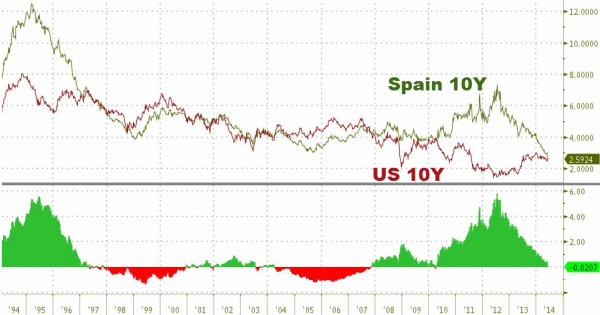Earlier today something happened which we haven’t seen since a very brief period of time in 2010, and then going all the way back to 2007:Â Spanish 10 Year bond yields tumbled below those on US 10 Year Treasurys.

So is this an indication that the Spanish bond market is suddenly safer, and more credible than that of the US? Of course not. All we are seeing is merely the manifestation of the latest ECB carry trade pushing local banks not to lend the ECB’s cheap money out to consumers, but to engage in yet another Draghi-subsidized carry trade.
DB’s Jim Reid explains:
There is some concern that drop in the cost of funding won’t find its way to the real economy… for four reasons.
- First, there is nothing in the documentation which was released yesterday which would prevent banks from using the proceeds to accumulate more government bonds, at least for the first 2 years (they would merely be forced to pay down the TLTRO half way through the operation if they fail to step up their lending to the private sector). This is at odds with Draghi’s statement in the Q&A in which he made it clear that the package is not designed to incentivise further “carry tradesâ€. Will we get more conditionality down the line to stop this?
- Second, substantially reducing banks’ medium term funding cost can be fully passed to final borrowers only if banks consider that they are comfortable with the current level of their interest margins on lending to the private sector. They have been increasing massively since mid-2012. Banks may want to raise them further, either because they consider that lowering the borrowing rate would not properly remunerate their credit risk, adjusted for the capital charge entailed by this type of activity, or because they still need to organically grow their capital ratio.
- Third, we don’t know the elasticity of the demand for credit to changes in borrowing rates, but in a context of a preference for deleveraging in some segments of the Euro area, this elasticity could well be lower than usual.
- Fourth, we should not forget that banks need to pay back the ECB EUR 450bn by February 2015, as the two LTROs expire. Even if they were to use the entirety of their EUR 400bn initial allotment in the TLTRO to fund this, there would still be a “net gap†of some EUR50bn. In a cynical view of the targeted LTRO, it could be considered as simply a 4 year extension of the existing LTRO, at a slightly cheaper cost (25 bps against c.65 bps) and with more visibility on the final cost. Seen in this light, it looks less innovative. For more on yesterday’s announcement please read their report.
I was at a big DB macro dinner last night and most clients and DB participants felt that the ECB had prolonged the carry trade whatever the scepticism over the effectiveness of the policy measures for the real economy. So this type of thinking might dominate in the near term.

